Release date(s) May 1982 Initial release date 1982 | Genre Action game | |
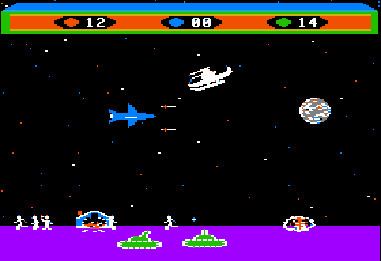 | ||
Developers Sega, Brøderbund Software, Dan Gorlin, Atari, Synapse Software, Creative software, Dan Gorlin Productions Similar Brøderbund Software games, Strategy video games | ||
Choplifter 1985 sega mame retro arcade games
Choplifter (stylized as Choplifter!) is a 1982 Apple II game developed by Dan Gorlin and published by Brøderbund. It was ported to Atari 5200, Atari 8-bit family, ColecoVision, Commodore 64, Commodore VIC-20, and MSX. Graphically enhanced versions for the Atari 7800 and Atari XEGS were published in 1988 by Atari.
Contents
- Choplifter 1985 sega mame retro arcade games
- Choplifter arcade
- Overview
- Gameplay
- Development
- Legacy
- Reception
- References
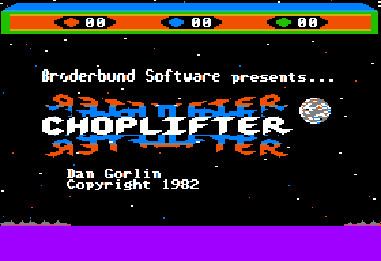
In 1985, Sega released a coin-operated arcade game remake, which in turn was ported to the Nintendo Entertainment System and Sega Master System in 1986. Choplifter is one of the few games that first appeared on a home system and was ported to the arcade.
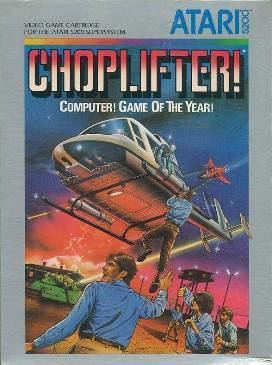
Choplifter arcade
Overview
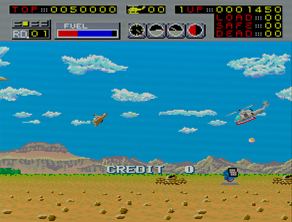
In Choplifter, the player assumes the role of a combat helicopter pilot. The player attempts to save hostages being held in prisoner of war camps in territory ruled by the evil Bungeling Empire. The player must collect the hostages and transport them safely to the nearby friendly base, all the while fighting off hostile tanks and other enemy combatants. According to the backstory, the helicopter parts were smuggled into the country described as "mail sorting equipment."
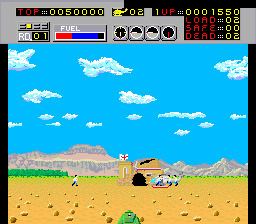
Although the Iran hostage crisis ended the year before the game was released, Gorlin has stated "the tie-in with current events was something that never really crossed my mind until we published."
Gameplay
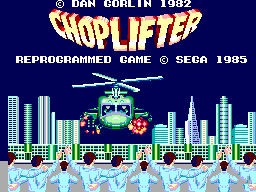
The helicopter (named "Hawk-Z" in the Master System version manual) can face three directions: left, right, or forward (facing the player). It may shoot at enemies in any of these directions and need not fly in the same direction it is facing. The forward-facing mode is used primarily to shoot tanks. Care must also be taken to both protect the hostages from enemy fire and not accidentally shoot them oneself.
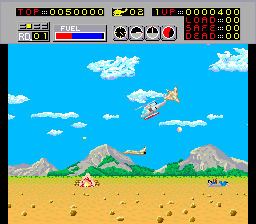
The player rescues the prisoners by first shooting one of the hostage buildings to release them, landing to allow the prisoners to board the sortie, and returning them to the player's starting point. Each building holds 16 hostages, and 16 passengers can be carried at a time, so several trips must be made. When the chopper is full, no more hostages will attempt to board; they will wave the helicopter off and wait (hopefully) for its return. Usually, each trip back is more risky than the previous one since the enemy is alerted and has deployed a counter-attack.
If the player lands directly on top of a hostage, or completely blocks the building exit, the hostage(s) will be killed. In the Apple II and Atari 7800 versions, hostages will also die if the vehicle is not landed correctly (it is slightly tilted), being crushed as they attempt to board the chopper. While grounded, the helicopter may be attacked by enemy tanks, which it can shoot at only by returning to the air. Also, the enemy scrambles jet fighters which can attack the vehicle in the air with air-to-air missiles or on the ground with bombs.
Development
Choplifter was developed in six months. After Gorlin began experimenting with animating a helicopter on the Apple II, he added scenery, tanks, and planes, with the hostages last. He stated that as "A story developed ... movie camera techniques seemed appropriate", including the final message "The End" instead of "Game Over". Gorlin's first demonstration to Broderbund was "too realistic, too much a helicopter simulation", and the company helped him make it easier to fly. The original Choplifter art for the Broderbund Commodore 64 release was produced by Marc Ericksen, who created the art for Broderbund's original first five covers.
Legacy
Choplifter II, subtitled "Rescue Survive," was released for the Game Boy (1991), then remade for both the Game Boy and Game Gear as Choplifter III in 1994. An unrelated Choplifter III was released for Super NES.
Sega released a pair of spiritual successors without the Choplifter brand:
inXile Entertainment released Choplifter HD for Xbox Live Arcade, PlayStation Network, and Windows on January 11, 2012.
Reception
Softline in 1982 called the game "what may well be the first Interactive Computer-Assisted Animated Movie. A fusion of arcade gaming, simulation, and filmic visual aesthetics, Choplifter is destined to occupy a place in the software Hall of Fame". The magazine praised the animation and the helicopter's "subtle flight control", and concluded that seeing the hostages' "hope and excitement, their faith in you" made the game "hard to play. It hurts to see one of those lively people killed". In 1983 its readers named Choplifter fourth on the magazine's Top Thirty list of Atari 8-bit programs by popularity. BYTE called Choplifter "great fun", and Computer Gaming World highly praised the graphics and animation. The Apple II version of the game received a Certificate of Merit in the category of "Best Computer Audiovisual Effects" at the 4th annual Arkie Awards, and shortly afterward Billboard named it Computer Game of the Year. The Addison-Wesley Book of Atari Software 1984 gave the game an overall A+ rating, calling it "a masterpiece". The book concluded that "the concept, graphics, and animation make this a delightful game".
Debuting in May 1982, the game sold 9,000 copies by June, appearing on Computer Gaming World's list of top sellers. II Computing listed Choplifter seventh on the magazine's list of top Apple II games as of late 1985, based on sales and market-share data.
In 2010 Choplifter was included in the book, 1001 Video Games You Must Play Before You Die.
